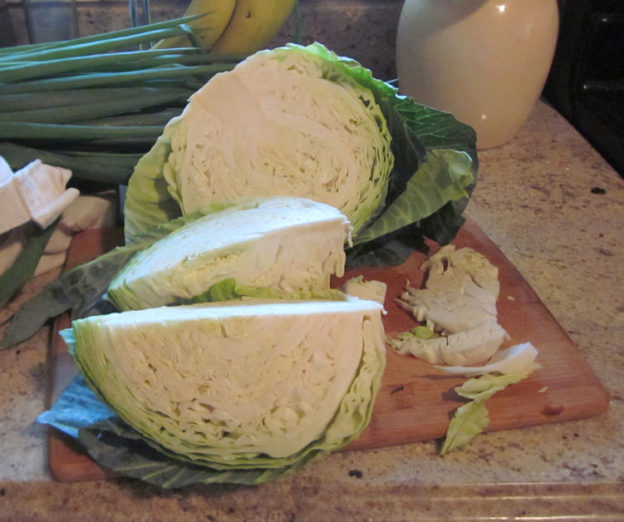Until recently, whenever I thought about cabbage I would remember the unwelcome smell that permeated the hallway of my grandmother’s building in Far Rockaway, NY. It would make my nose wrinkle and I couldn’t wait to get into her apartment which always seemed to smell like fresh baked dinner rolls or something equally delicious.
So, I quite surprised myself when I picked up a head of cabbage at the farmer’s market. I did it for two reasons: 1. I know how nutritious it is. 2. It was only $2. WIN, WIN!
I pondered what to do with it on the way home. Then I surprised myself again by slapping the steering wheel and declaring out loud, “I am going to make sauerkraut!” I have no idea where the thought came from since I never made it before and quite frankly… I never even really thought about sauerkraut being comprised of cabbage. The same goes for coleslaw (which I also decided to make.)
How hard could it be? It turns out, not hard at all. It became clear after some quick research that sauerkraut is merely cabbage+salt+time. I chopped the cabbage as thin as I could by hand, threw in a few tablespoons of kosher salt and began to massage it. I found myself wondering how many of my German ancestors must have done the very thing I was doing at that moment. It felt so natural working the salt into the cabbage until the juices flowed out. After about 10 minutes, I decided I created enough of a brine to jar it up. You want there to be enough liquid to fully submerge the kraut. I used an onion* half to weigh it down in the jar. After that, I topped the jar with a coffee filter and rubber band. I found this set-up very effective for keeping the oxygen out while allowing the carbon dioxide to escape. Then I set the jar in a dark cabinet in the basement, the only place that might come close to maintaining the ideal temperature range of 65 to 75 degrees.
How does this make sauerkraut? The short answer is that cabbage naturally carries bacteria like lactobacilli which helps kick off lactic acid fermentation. The salt preserves the cabbage to keep it from rotting while fermentation takes place. There is a lot of debate about the proper amount of time to allow sauerkraut to ferment, anywhere from three days to six months. I found the most consensus that around three weeks is enough time. The idea is to allow the sauerkraut to ferment long enough to produce a goodly amount of probiotic bacteria. Then after that it’s just about taste.
However, if you are like me and you can’t wait that long or if the average temp is above 75 degrees then two weeks is long enough. Also, keep in mind, the sauerkraut will continue to ferment in the fridge. It will just happen much more slowly below 65 degrees.
I have to tell you that homemade sauerkraut is DELICIOUS! It is so much better than store-bought. I am not sure I could eat the canned stuff ever again. Give it a try if you like sauerkraut. You have nothing to lose. I paid two dollars for a head of cabbage at the farmer’s market. (I noticed they are $1.29 at the supermarket.) That one head netted me 16 ounces of sauerkraut and eight cups of coleslaw. I call that VERY budget-friendly!
I will get more into the nutritional and weight loss benefits of cabbage in my next post, as well as share the coleslaw recipe I concocted.
Many Blessings,
Cynthia
*I got the onion as a weight idea from the Dr Axe website: https://draxe.com/recipe/sauerkraut-recipe/
Please follow me on Twitter. Also, please LIKE my Facebook Page.




Cabbage like brussel sprouts don’t get enough attention for sure!!! Bon appetit!!!!
I prefer the cole slaw myself……lol….
I like both, especially when they are homemade. It makes such a big difference.
I love lactofermented sauerkraut! I do what you did, except I also use Caldwell’s starter culture. I guess I don’t really need that. I can’t remember where I got the recipe, but I also add caraway seeds, which adds a nice flavor. I haven’t made it in a while, you’ve inspired me to make a new batch. I don’t think you mentioned that is shouldn’t be cooked. As you know cooking kills the “good” bacteria. The idea about the onion is brilliant.
I have to say though I LOVE cabbage – I’m glad you’re doing a whole series! I add it to soups all the time, just little slivers that kind of dissolve, but add so much flavor. Tonight I put cabbage in a roasting pan with some red onion, cut up carrots, salt, turmeric, and olive oil. Roasting gives it a really nice rich flavor.
Blessings back at ya…
Thanks for the well-written comment Jodi. I am glad you mentioned the “not cooking” part. Sometimes, I can’t include everything I want to and keep the proper length and flow. That’s definitely an important point though and I wish I hadn’t left it out.
I made a cabbage soup one week too and found it tasty and filling. I am intrigued by this roasting technique you mention. How do you cut it up when you roast it? Do you cut it thin still and separate the strips or leave it kind of chunky?
I never responded to you – so sorry. I don’t think I got notified, but it was last August – who can remember. Just for the record, I leave it kind of chunky, spritz it with a little olive oil & flip it half way through, I put the onion in at the beginningI add the carrots in about halfway through the process. I cut the carrot about the size of a baby carrot, sometimes I just use baby carrots.
Sounds yummy!
I’ve always been nervous about trying to make sauerkraut or ferment any type of food. It’s scary to me! I worry that I’d do something wrong and end up in the hospital. Ha. Thanks for showing that it’s possible. 🙂
Lol. Believe me, if I can do it, anyone can. Cabbage is so cheap; even if you make a mistake, it’s not a budget buster if you need to dump it. :-). I am sure you would have no problem at all!